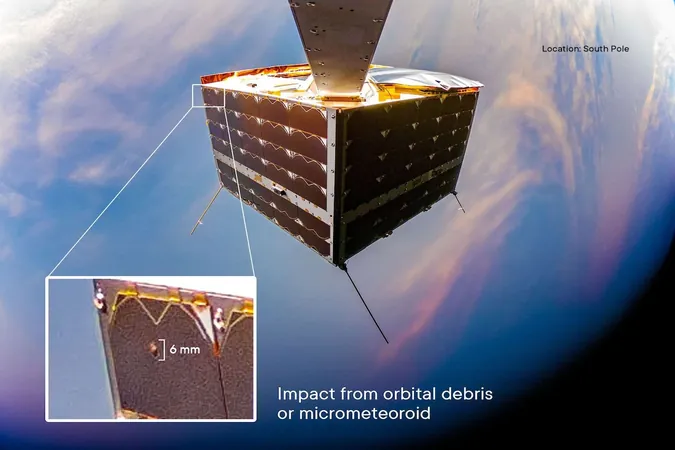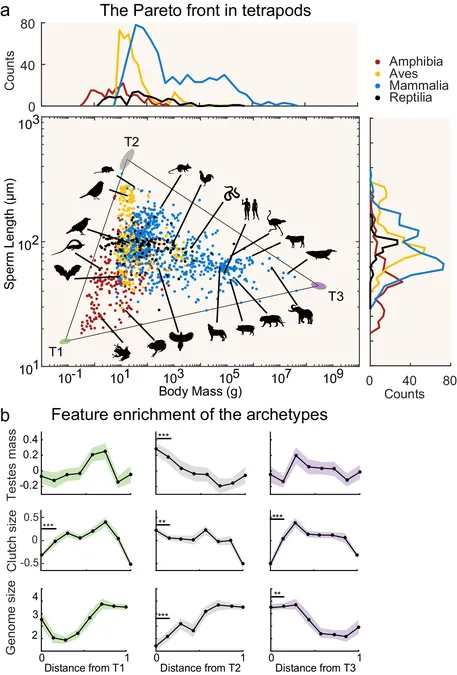
Mysterious Impact Leaves Satellite with a Hole: Is Space Debris the Culprit?
2024-10-31
Author: Ming
In an increasingly crowded orbital environment, space is becoming something of a cosmic minefield. A recent incident involving the NanoAvionics MP42 microsatellite has highlighted the potential dangers faced by satellites today. A selfie taken by the satellite revealed a perplexing 0.2-inch hole (around 6 millimeters) on one of its solar panels, hinting at an unidentified impact that likely occurred within the past year.
This stunning discovery was made public by NanoAvionics, which explained that the satellite's onboard camera captured the damage earlier this month. While the company has humorously acknowledged the remote possibility of an “alien satellite-pecker” causing the damage, they speculate that a wayward piece of space debris or a micrometeoroid is the more likely suspect.
Determining when the impact occurred is a challenge since the last selfie of MP42 was snapped in April 2023. This mystery adds to the intrigue, as the satellite could have been hit anytime over the last year and a half. However, despite the damage, MP42 is still performing its functions successfully without any noticeable dip in power generation abilities, making it all the more difficult to ascertain the exact timing of the impact.
NanoAvionics stressed the importance of responsible operations in space, particularly as satellite technology becomes more prevalent. "Whether this impact was caused by a micrometeoroid or a piece of space debris, it underscores the necessary resilience that satellites must have against such events," the company noted.
The situation reflects broader concerns regarding space debris: over 27,000 pieces are being tracked by the Department of Defense's Space Surveillance Network, with countless smaller fragments likely floating around unnoticed. The risk of collision poses a serious threat to operational satellites. Just recently, a communications satellite fragmented in orbit, leading to nearly 500 bits of uncontrolled debris — a stark reminder of the dangers surrounding orbiting satellites.
The International Space Station (ISS) has executed 32 maneuvers to avoid such debris between 1999 and 2022, showcasing the real-time risks that space crews face, as well as the impact of space junk on their missions.
Launched in April 2022 as part of the SpaceX Transporter-4 mission, the MP42 serves as a pathfinder for NanoAvionics' M6P cubesat platform, designed for a variety of space applications. Notably, NanoAvionics has equipped its satellites with propulsion systems meant for controlled deorbiting, a step towards alleviating the ongoing space debris crisis.
As more companies enter the space race, addressing issues of debris management and sustainability in orbit will be paramount. With the expansion of satellite technology and the number of objects in low Earth orbit, the call for conscientious operations is more critical than ever — after all, in the vastness of space, the repercussions of negligence could lead to catastrophic consequences. Will we see an overhaul in how we approach satellite missions? The clock is ticking, and the cosmos won't wait.




 Brasil (PT)
Brasil (PT)
 Canada (EN)
Canada (EN)
 Chile (ES)
Chile (ES)
 España (ES)
España (ES)
 France (FR)
France (FR)
 Hong Kong (EN)
Hong Kong (EN)
 Italia (IT)
Italia (IT)
 日本 (JA)
日本 (JA)
 Magyarország (HU)
Magyarország (HU)
 Norge (NO)
Norge (NO)
 Polska (PL)
Polska (PL)
 Schweiz (DE)
Schweiz (DE)
 Singapore (EN)
Singapore (EN)
 Sverige (SV)
Sverige (SV)
 Suomi (FI)
Suomi (FI)
 Türkiye (TR)
Türkiye (TR)